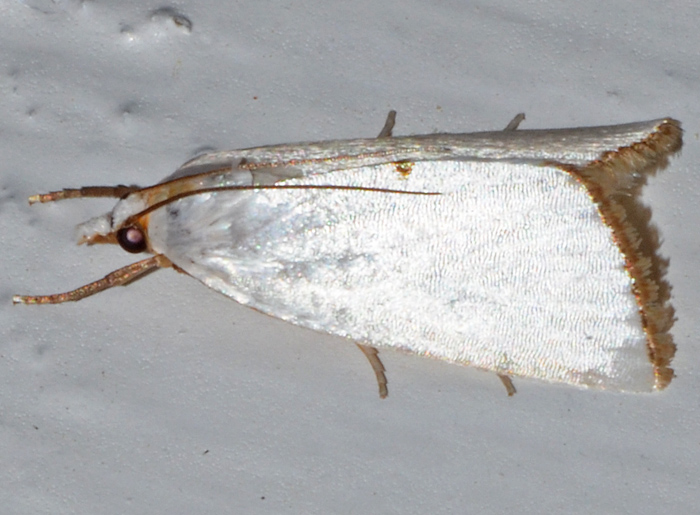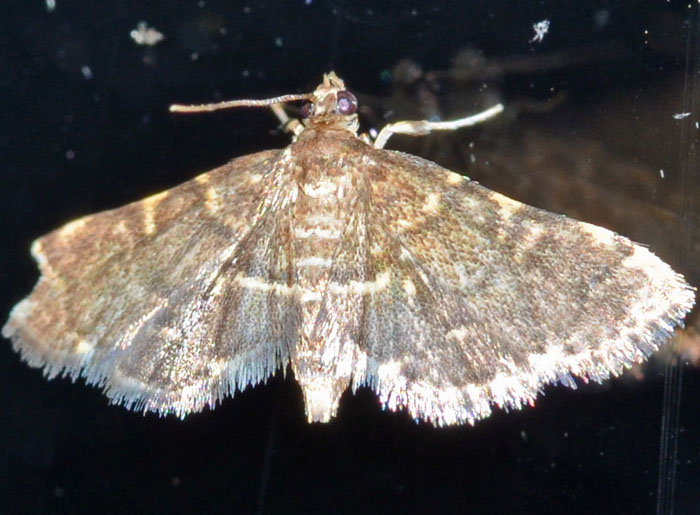 Anageshna primordialis - Hodges#5176 | Another brownish moth ... The "color" pattern on the wings is apparently characteristic. bug guide (this photo): http://bugguide.net/node/view/976346 | ||
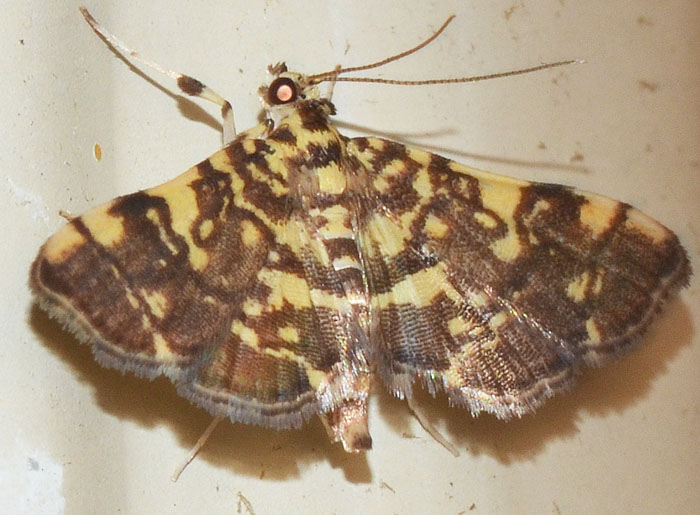 Apogeshna stenialis - Hodges#5177 | This small moth is the Checkered Apogeshna. The word root "Geshna" is Hindi and means singer. What fascinated me about this moth is its white/dark chocolate-like appearance. bug guide (this photo): http://bugguide.net/node/view/1101971 | ||
 Argyria lacteella - Hodges#5463. | This bright silvery moth is Argyria lacteella. It is very similar to the Snowy Urola which lacks the dark spots on the forewing. bug guide (this photo): http://bugguide.net/node/view/577896 Moth Photographers Group: http://mothphotographersgroup.msstate.edu/species.php?hodges=5463 | ||
 Chalcoela pegasalis - Hodges#4896 | Very pretty for a little, brown moth, but this moth holds a dark secret. Its larvae feed on the larvae of the common wasp Polistes. Accordingly, the moth can be found around homes or anywhere in the vicinity of the wasp nests. bug guide (this photo): https://bugguide.net/node/view/1794174 M. A. Solis via ResearchGate: https://tinyurl.com/Chalcoela | ||
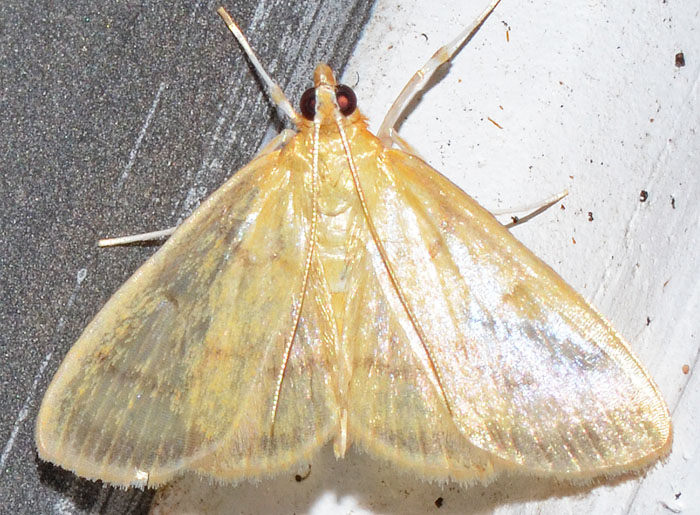 Crocidophora tuberculalis - Hodges#4945 | One of three species in North America. bug guide (this photo): http://bugguide.net/node/view/1106114 | ||
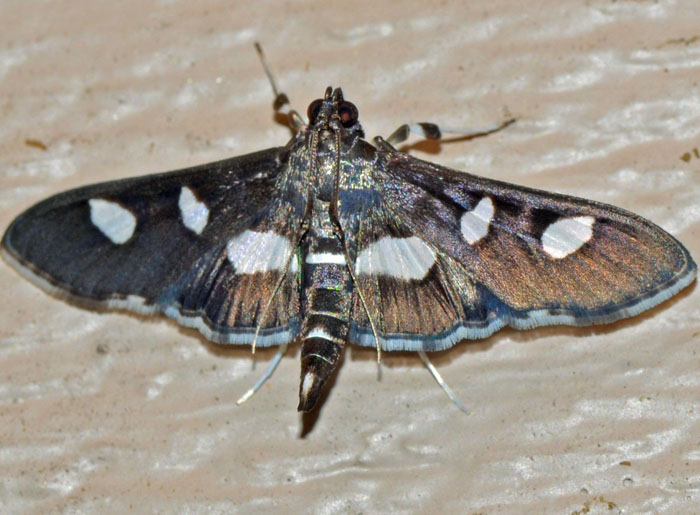 Desmia sp. (Grape Leaffolder (nonspec.)). | The photo shows either Desmia funeralis or D. maculalis. To distinguish between these two species, a ventral view is needed that reveals the markings on the abdomen. The gender can be distinguished based on the shape of the antennae. Unfortunately I could snatch only this one photo because the moth flew away after seeing the camera flash. This Grape Leaffolder flies during the day but is also attracted to lights during the night (like this specimen). It reminded me of my first semi-serious bug photo (a skipper) that I had identified incorrectly as D. funeralis. bug guide (this photo): http://bugguide.net/node/view/985587 | ||
 Diacme adipaloides - Hodges#5143 (Darker Diacme Moth). | This moth is D. adipaloides which is also known as the Darker Diacme Moth. It is similar to the Paler Diacme, but the darker forewing is grayish brown with irregular pale orange bands; the hindwing is paler yellow with a wide brown border. This species is widespread in the eastern United States.
bug guide (this photo): http://bugguide.net/node/view/1122483 Discover Life: http://www.discoverlife.org/mp/20q?search=Diacme | ||
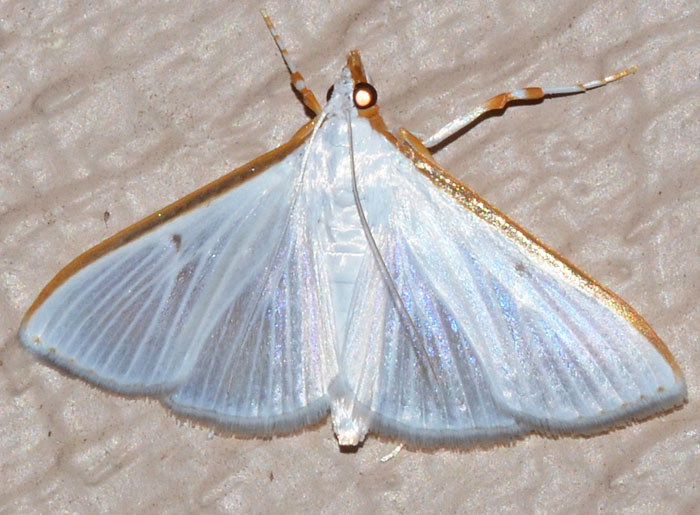 Diaphania costata - Hodges#5216. | This Snout Moth can be found in Texas, Louisiana, and obviously Florida. Until recently, it was known as Stemorrhages costata. It is a pest of Confederate Jasmine and can be easily confused with Palpita kimballi. bug guide (this photo): http://bugguide.net/node/view/1122485 | ||
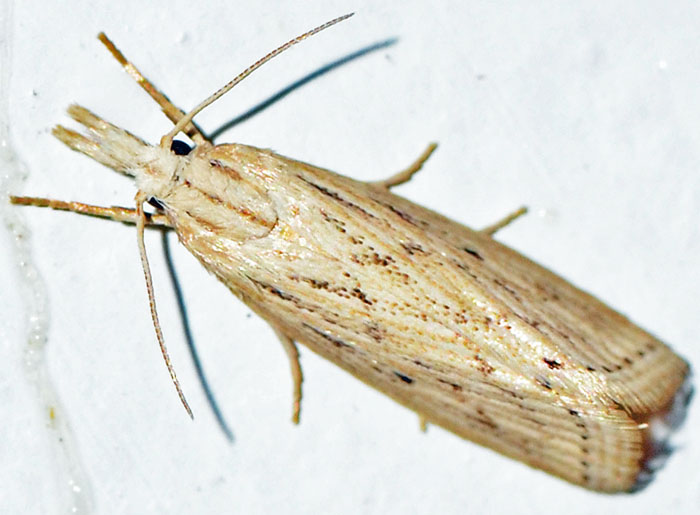 Diatraea lisetta - Hodges#5481 (Diatraea Moth). | The genus has seven species in North America. It seems most abundant in the Southeast. bug guide (this photo): http://bugguide.net/node/view/981336 | ||
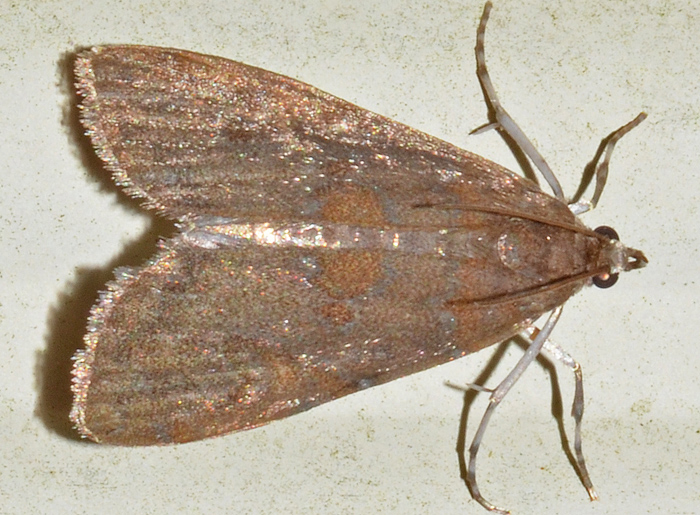 Elophila gyralis - Hodges#4751 (Waterlily Borer). | Larvae of this moth feed on the leaves of waterlilies. More precisely, they bore into the stalk (petiole) that attaches the leaf blade to the stem. The adult is sexually dimorphic: females are usually unmarked orangish-yellow to dark brown, while males can have more intricate patterns and be grayish.
bug guide (this photo): http://bugguide.net/node/view/1205444 | ||
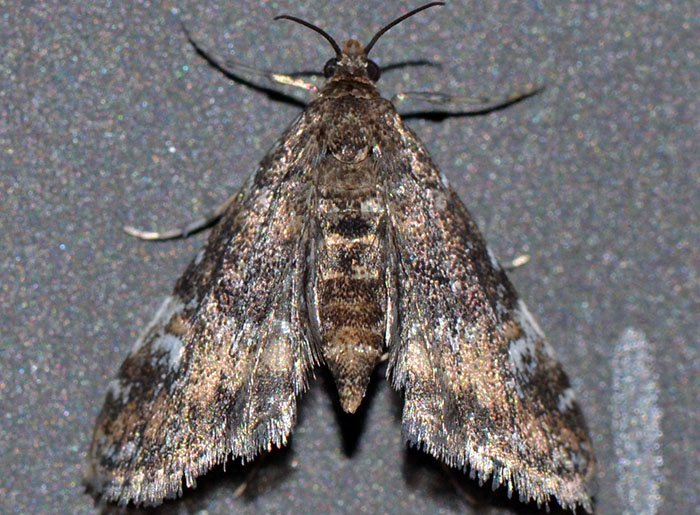 Elophila obliteralis - Hodges#4755 | The Waterlily Leafcutter is known to damage the invasive hygrophila and hydrilla. The UF link states: "The larvae are the stage that feeds on the plants and causes damage to the plant tissue. In addition to feeding, the larvae cut the leaves to prepare a leaf case for shelter. As the larvae develop, they cut new, progressively larger leaf cases. This action in itself can provide quite significant damage to the infested plant. In a field study, to compare the effect of herbivory on different aquatic plants, E. obliteralis was one of the three species that caused the most damage. When feeding the larvae remove chunks from the leaves, usually feeding on the basal or middle portions. This feeding often causes the leaves to break away from the stem. If the population density is high (...), the larvae will begin to feed on the stems, which can cause the entire plant to fragment."
UF: http://entnemdept.ufl.edu/creatures/beneficial/leps/waterlily_leafcutter.htm | ||
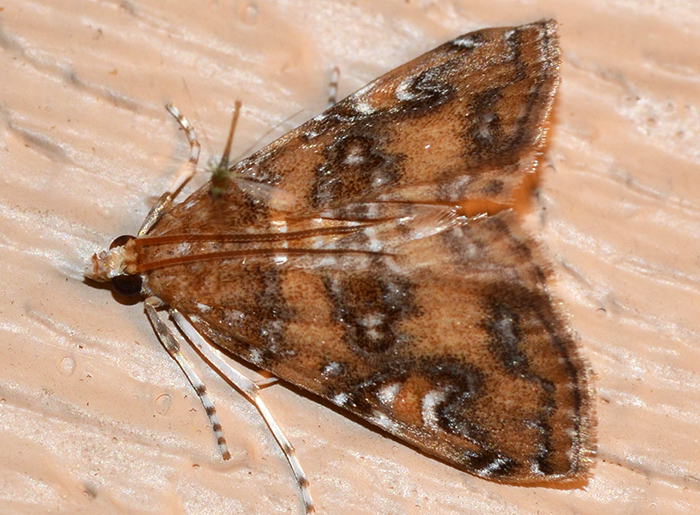 Elophila gyralis - Hodges#4751 (Waterlily Borer) ♂. | ... and here's a male of E. gyralis. For more information, please see above. bug guide (this photo): https://bugguide.net/node/view/1512174 | ||
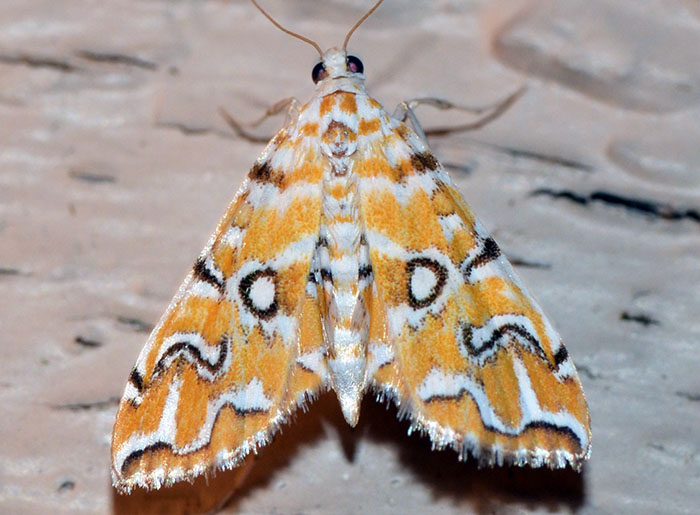 Elophila icciusalis - Hodges#4748 (Pondside Pyralid). | And another species in the genus Elophila: the Pondside Pyralid. The larvae are aquatic and also the adult moths are found near this habitat. They are also attracted to light. Looking at other photos on the internet, I think this is a particularly beautiful specimen.
bug guide (this photo): https://bugguide.net/node/view/1584055 | ||
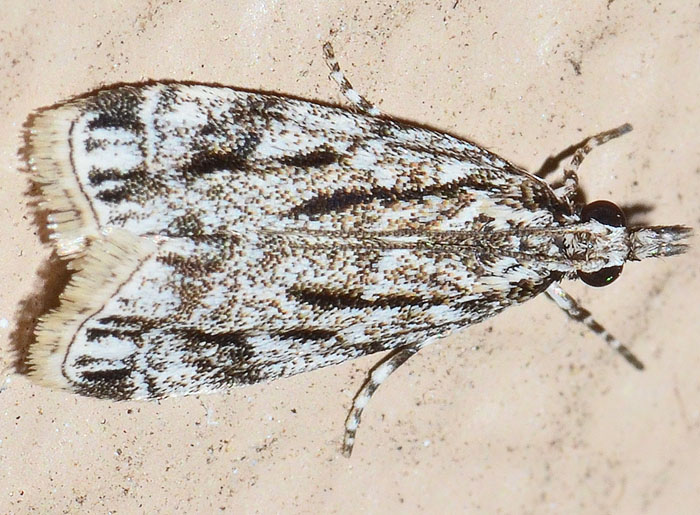 Eudonia strigalis - Hodges#4738 (Striped Eudonia). | I found this moth during the fast warm evening of the year. We had the porch light on and suddenly a bunch of insects were back. Eudonia has 18 species in America north of Mexico. The wingspan of this species is about 15 mm. The second link takes you to the original description of this species (back then Scoparia strigalis). bug guide (this photo): http://bugguide.net/node/view/1198468 H. G. Dyar, J. New York Entomol. Soc. 14, 77, 1906.: http://www.jstor.org/stable/25003201 | ||
 Glaphyria glaphyralis - Hodges#4869 | To the eye this little moth looked like a shiny, yellowish golden triangle or pyramid. The genus Glaphyria has six species in North America. bug guide (this photo): http://bugguide.net/node/view/977909 | ||
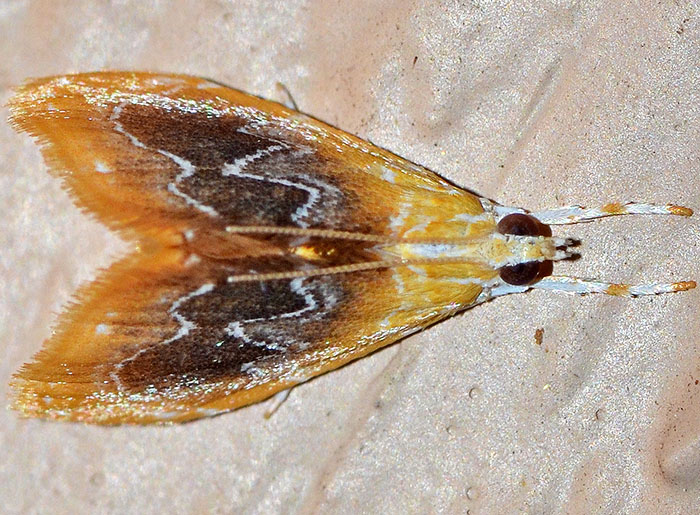 Glaphyria fulminalis - Hodges#4873 | One of six Glaphyria species in North America. This one has most of the eastern half of the country as its range. The wingspan is about 11 mm. bug guide (this photo): https://bugguide.net/node/view/1581517 | ||
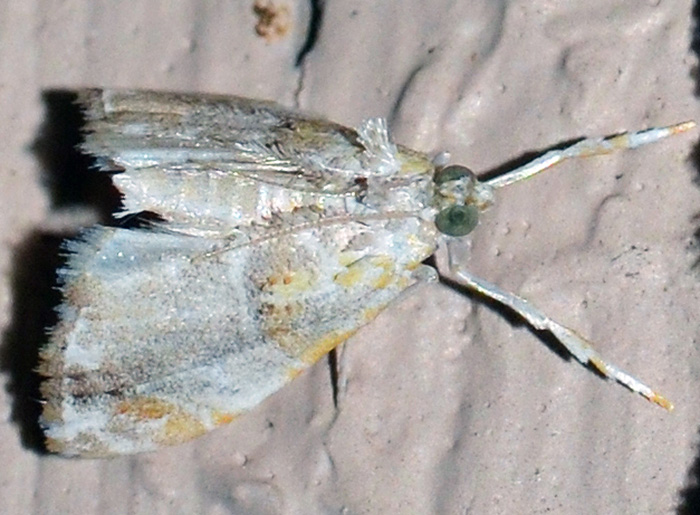 Glaphyria basiflavalis - Hodges#4871 | Glaphyria basiflavalis is also known as the basal-dash glaphyria moth and was first described by William Barnes and James Halliday McDunnough in 1913. It is found in North America, where it has been recorded from Alabama, Florida, Mississippi and Texas. bug guide (this photo): https://bugguide.net/node/view/1665494 wikipedia: https://en.wikipedia.org/wiki/Glaphyria_basiflavalis | ||
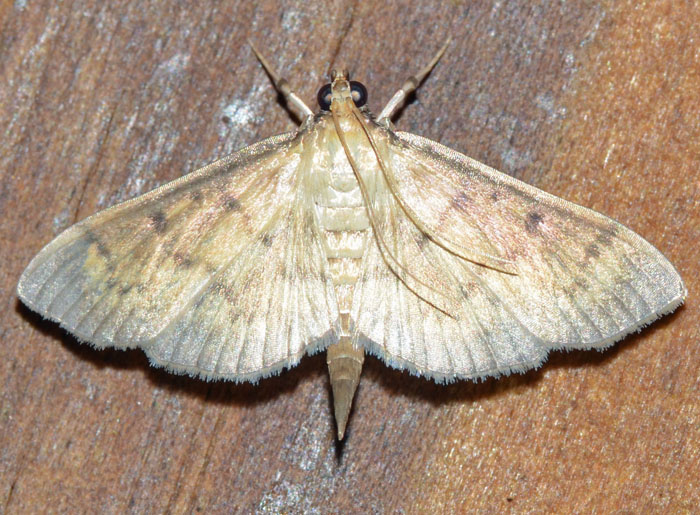 Herpetogramma sp.. | Herpetogramma has 10 species in North America. The caterpillars are often called webworms or sod webworms. Most species feed on grasses and some on ferns. This specimen is perhaps H. phaeopteralis (tropical sod webworm) which is a destructive pest of warm season turfgrasses in the southeastern US (see second link). bug guide (this photo): http://bugguide.net/node/view/973650 UF: https://edis.ifas.ufl.edu/in968 | ||
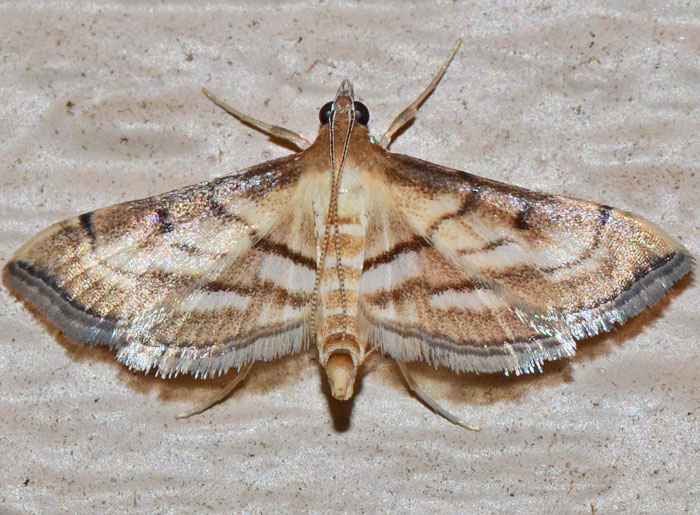 Marasmia trapezalis - Hodges#5288 (Trapeze Moth). | This Trapeze Moth is very similar to the Marasmia Moth (M. cochrusalis) but in the latter, the PM lines on the forewing and the hindwing line up on the spread wings. The Trapeze Moth is also called Rice Leaffolder because its larvae feed on leaves of corn, rice, and other grains and the second and later instars feed within the rolled leaf. The larvae are greenish-yellow with stiff brown bristles and wiggle when disturbed.
bug guide (this photo): http://bugguide.net/node/view/1129265 | ||
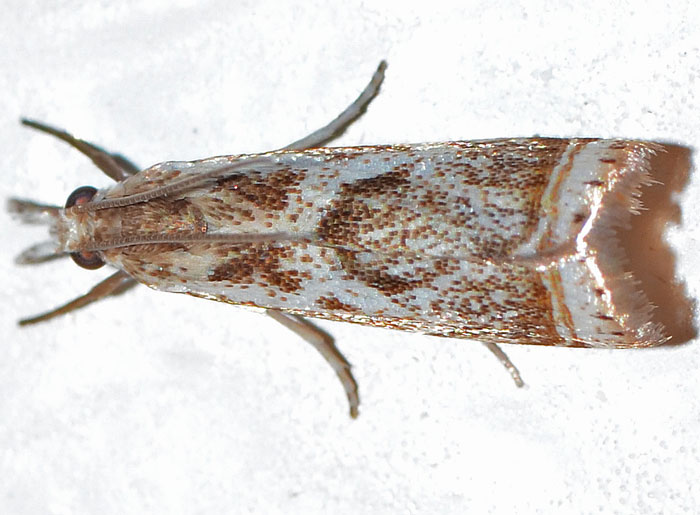 Microcrambus elegans - Hodges#5420 | At rest this moth has a Halloween mask on its forewings with two upward-pointing "eyes" and a frowning down-curved "mouth". This pattern is a distinctive feature for this species which is quite common in the eastern half of the US. It prefers fields and grassy areas. The adults are active during twilight and into the night. They are attracted to light.
bug guide (this photo): http://bugguide.net/node/view/979119 | ||
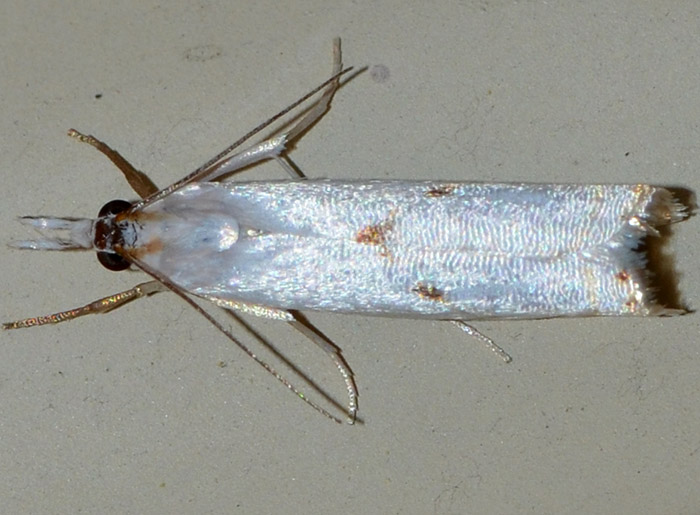 Microcrambus biguttellus - Hodges#5419 | The forewings of the Gold-stripe Grass-veneer have a length of about 8 mm and are white with angled lines near the costa. There are also black dots along the inner margin of the median line. The larvae feed on various grasses. Adults can be found year round in Florida.
bug guide (this photo): https://bugguide.net/node/view/1506220 wikipedia: https://en.wikipedia.org/wiki/Microcrambus_biguttellus | ||
 Nomophila nearctica - Hodges#5156 (Lucerne Moth). | The larvae of this nocturnal moth are called False Webworm or Celery Stalkworm. At rest the wings of the adult overlap and are hugged against the abdomen, which gives the moth a long and narrow profile.
bug guide (this photo): http://bugguide.net/node/view/951182 | ||
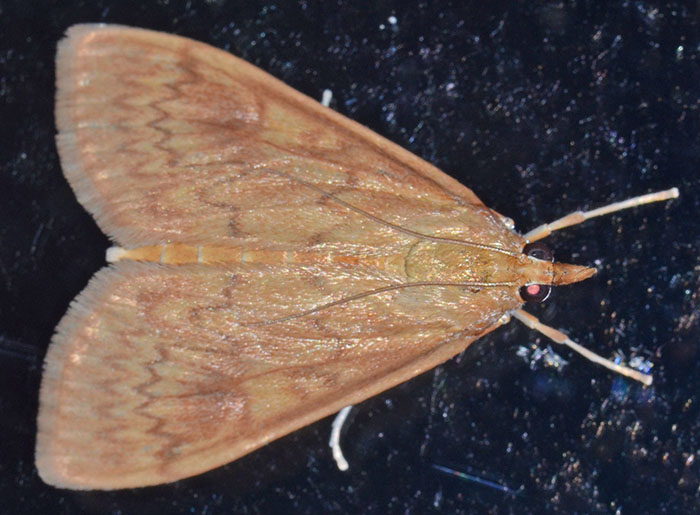 Ostrinia penitalis - Hodges#4946 | Nice species name, haha. These reddish moths live in marshes and near ponds where their foodplants (American Lotus Nelumbo lutea and smartweed Polygonum spp.) grow. The second link provides information on the American lotus plant.
bug guide (this photo): http://bugguide.net/node/view/1443182 UF (plant info): http://edis.ifas.ufl.edu/ag380 | ||
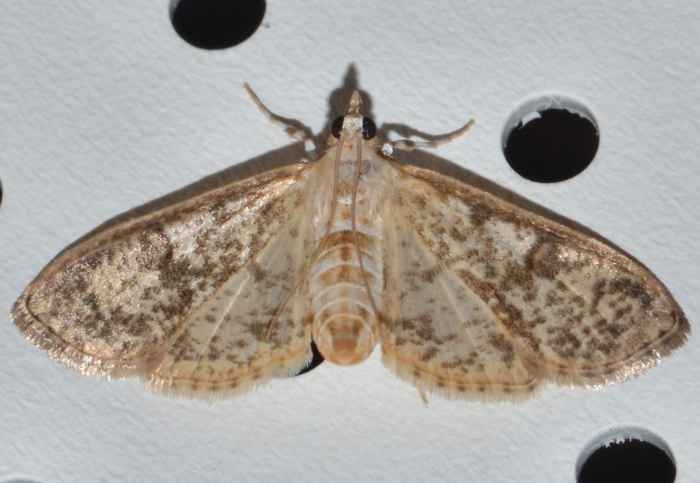 Palpita sp.. | The genus Palpita has 10 species in North America. The small photo shows another specimen that might be a different species in Palpita (photo taken on 08/02/12).
bug guide (this photo): http://bugguide.net/node/view/568512 bug guide (small photo): http://bugguide.net/node/view/683766 | ||
 Parapediasia decorellus - Hodges#5450 | The Graceful Grass-veneer Moth is graceful indeed. I really like the intricate pattern along the end of its hindwings. There are at least five US species in this genus. bug guide (this photo): https://bugguide.net/node/view/1066541 | ||
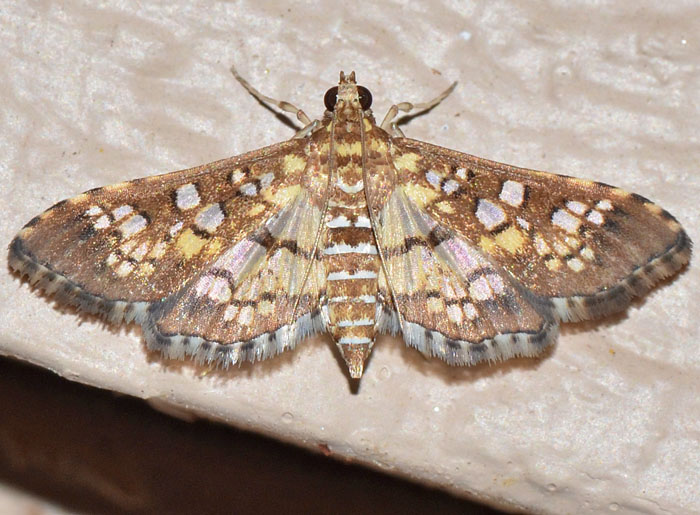 Samea ecclesialis - Hodges#5150 (Assembly Moth). | The Assembly Moth (Samea ecclesialis) belongs to the Crambid Snout Moth family. I think it has a beautiful wing pattern. The small photos were taken on 04/24/12 at 10 pm (left) and 08/03/11 at 9 am (right).
bug guide: http://bugguide.net/node/view/74202 moth photographers group: http://mothphotographersgroup.msstate.edu/species.php?hodges=5150 | ||
 Urola nivalis - Hodges#5464 (Snowy Urola). | A beautiful little moth. The wing span is about 2 cn. The silvery-white wings have a satin sheen and when the moth rests, the wings are folded over body in a tent-like fashion. Also the head and the palps are white. The Snowy Urola has a small dark mark at the midpoint of inner margin of forewing. The lack of additional spots distinguishes it from the similar Argyria lacteella. The small photo shows the same specimen.
bug guide (this photo): http://bugguide.net/node/view/1208176 |




